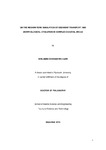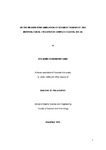On the Medium-Term Simulation of Sediment Transport and Morphological Evolution in Complex Coastal Areas
| dc.contributor.supervisor | Greaves, Deborah | |
| dc.contributor.author | Williams, Benjamin Graham | |
| dc.contributor.other | Faculty of Science and Engineering | en_US |
| dc.date.accessioned | 2016-11-10T16:20:23Z | |
| dc.date.issued | 2016 | |
| dc.date.issued | 2016 | |
| dc.identifier | 810087 | en_US |
| dc.identifier.uri | http://hdl.handle.net/10026.1/6704 | |
| dc.description | Edited version embargoed until 10.11.2017 Full version: Access restricted permanently due to 3rd party copyright restrictions. Restriction set on 11.11.2017 by SC, Graduate School | |
| dc.description.abstract |
A program for selecting the optimal wave conditions for morphodynamically accelerated simulations of coastal evolution (‘OPTIWAVE’) has been constructed using a novel Genetic Algorithm approach. The optimization routine iteratively reduces the complexity of an incident wave climate by removing the events that contribute least to a target sediment transport pattern, and then ‘evolving’ a new set of weights for the remaining wave conditions such that the target sediment transport pattern (and magnitude) is optimally maintained. The efficacy of OPTIWAVE to satisfactorily reduce the incident wave climate is tested against three coastal modeling paradigms of increasing complexity: (a) A simple 1-D beach profile model (no tides); (b) A 2-D micro-tidal beach; (c) A tidal inlet, where the interaction between waves, tides, and wave-current interaction, adds significant complexity. The simple test case for a beach profile shows that OPTIWAVE is successfully capable of maintaining a target profile-integrated long-shore sediment transport rate. The calculated skill and RMSE of the reduced wave climate is a good indicator of its ability to reproduce the target sediment transport pattern. The optimal number of wave conditions is identified by an ‘inflection point’ at a critical number of wave conditions, where less complex a wave climate results in substantially reduced skill (increased error). The assumption that the ability of OPTIWAVE to reproduce a target sediment transport field is a valid proxy for the potential skill of a morphologically accelerated simulation is assessed for the case of a 2D micro-tidal beach. The skill of the accelerated models, which use a state-of-the-art ‘event-parallel’ method of simulating bed evolution from multiple wave conditions in parallel, is tested against a ‘brute force’ reference simulation that considers the full wave forcing. A strong positive correlation is found between the skill of the reduced wave climate to reproduce a target sediment transport pattern, and the resultant skill of the accelerated morphodynamic model against the ‘brute force’ reference simulation. Finally, the ability to combine reduced wave and tide climates for simulations that must consider both wave and tidal forcing, is assessed against a ‘brute force’ reference simulation of the seasonal evolution Ancao inlet, Algarve, Portugal. The reference simulation is validated against a comprehensive field dataset collected in 1999, and is shown to qualitatively reproduce key features of inlet behavior over a seasonal period. The combination of reduced wave and tidal climates in accelerated ‘event-parallel’ models did not successfully reproduce the reference seasonal morphological evolution of Ancao inlet. Assessing the model Brier Skill Score showed that the model was more successful in reproducing the reference morphology in areas dominated by tidal forcing, but did not have any predictive power in regions where morphological evolution is due to some combination of both wave and tidal processes. | en_US |
| dc.description.sponsorship | Engineering and Physical Sciences Research Council (EPSRC) | en_US |
| dc.language.iso | en | |
| dc.publisher | University of Plymouth | |
| dc.rights | Attribution-NonCommercial-NoDerivs 3.0 United States | * |
| dc.rights.uri | http://creativecommons.org/licenses/by-nc-nd/3.0/us/ | * |
| dc.subject | Morphological Modelling | |
| dc.subject | Morphological Acceleration | |
| dc.subject | Wave Climate Reduction | |
| dc.subject | Genetic Algorithm | |
| dc.subject | Global Optimisation | |
| dc.subject | Tidal Inlet | |
| dc.subject | Ancao | |
| dc.subject | Ria Formosa | |
| dc.subject | Sediment transport | en_US |
| dc.subject.classification | PhD | en_US |
| dc.title | On the Medium-Term Simulation of Sediment Transport and Morphological Evolution in Complex Coastal Areas | en_US |
| dc.type | Thesis | |
| plymouth.version | non-publishable | en_US |
| dc.identifier.doi | http://dx.doi.org/10.24382/1075 | |
| dc.type.qualification | Doctorate | en_US |
| rioxxterms.funder | Not available | en_US |
| rioxxterms.identifier.project | Not available | en_US |
| rioxxterms.version | NA |
Files in this item
This item appears in the following Collection(s)
-
01 Research Theses Main Collection
Research Theses Main




